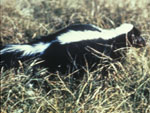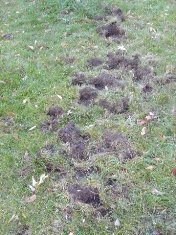Skunk Damage

Skunks have been out and about in the area, causing damage to lawns and gardens. In the fall, these mammals tend to dig in the yard, searching for grubs and other insects in the soil as they fatten up in preparation for winter. Kansas has two species of skunk, the spotted skunk, and the striped skunk. The spotted skunk or “civet cat” is now rare to find in our area and is currently listed as an endangered species. The most common is the striped skunk, with two white stripes down the back and a pungent odor. While they are probably the wildlife we least like to see on a walk, these critters are an essential part of the ecosystem as half of their diet is insects, with the remainder being fruit and mice.
In the fall, young skunks are weaned by their mothers in what’s termed the “fall shuffle,” this is often when you see skunks in yards, killed on the road, and close to people and animals. Skunks have a perfect sense of smell and will seek out grubs by smelling in lawns and then dig them up, similar to the photo at the right, searching for their next meal. The best way to keep skunks out of the yard is prevention. Check for grubs in your lawn and treat when you have 10 or more per square foot. Block any openings that skunks may decide to use as a den, especially in the spring when the females are looking for places to have their young, and keep a fence around your compost piles to prevent skunks from trying to use them as a food source during the summer.
If skunks continue to be a problem, you can try to trap them using a live trap. Bait the trap with canned cat food or canned tuna, place the food at the back of the trap, and leave it out at night. Traps should be set where skunks are expected to be, such as near den openings, along sides of buildings, trails, or fence openings. Traps can be set in the open or concealed with boards or grass. Always set traps in shady areas on a flat, smooth surface, using drift fences to guide skunks into the traps. Kansas law requires that traps be inspected at least once a day. Be aware that you will likely catch some neighborhood cats in your trap and any skunks in urban areas. If you see a skunk, cover the trap with a tarp or dark cloth to help keep the skunk calm before you relocate it. Notably, most skunks moved from their home range do not survive in their new home. Any skunk exhibiting aggressive tendencies should be handled cautiously, as they may have rabies. Contact animal control and keep pets or other humans away till the skunk is captured to prevent being bitten by possibly rabid skunks.
cat food or canned tuna, place the food at the back of the trap, and leave it out at night. Traps should be set where skunks are expected to be, such as near den openings, along sides of buildings, trails, or fence openings. Traps can be set in the open or concealed with boards or grass. Always set traps in shady areas on a flat, smooth surface, using drift fences to guide skunks into the traps. Kansas law requires that traps be inspected at least once a day. Be aware that you will likely catch some neighborhood cats in your trap and any skunks in urban areas. If you see a skunk, cover the trap with a tarp or dark cloth to help keep the skunk calm before you relocate it. Notably, most skunks moved from their home range do not survive in their new home. Any skunk exhibiting aggressive tendencies should be handled cautiously, as they may have rabies. Contact animal control and keep pets or other humans away till the skunk is captured to prevent being bitten by possibly rabid skunks.
There are treatments if a skunk has sprayed your pet or a human. Mix ¼ cup baking soda, a fresh 1-quart bottle of 3 percent hydrogen peroxide, and 1-2 teaspoons of liquid dish detergent in an open container. This solution must be used right away and cannot be stored. For pets and people, thoroughly work the mixture into the fur, hair, or skin, avoid the eyes and mouth, and leave for 5 minutes. Then rinse with fresh water and repeat if necessary. If a skunk has sprayed under your house or in a building, there is a product you can get through the Extension office called Nil Odor that will help get rid of the smell.

Have questions? Contact our office where our Horticulture Extension Agent will assist you with questions.
Phone: (316) 321-9660
Email: callae@ksu.edu